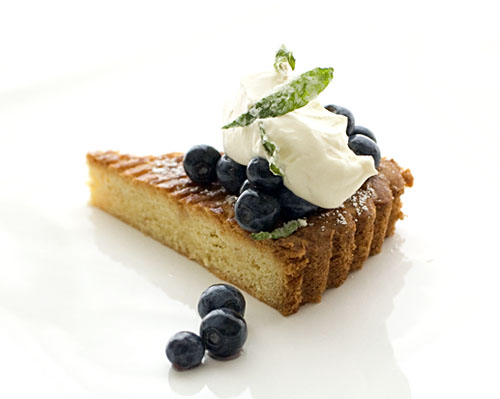December 30, 2009 at 9:17 am

(Gâteau Breton with lemon verbena cream and blueberries)
Very recently, one of the members of our work team resigned from his position. He had not been working there very long but even so, I felt overcome with sadness when I heard the news. The kitchen environment is very much all about operating as a team – we celebrate successes and bear the burden of failures as a team. If a few cogs from the machine fail or go missing, then the system starts to break down quickly.
The way in which any kitchen operates, fascinates me even to this day. We get a lot of visitors asking to take a look inside this current kitchen and their interest is not surprising at all. As my work station is located in a corner of the room, I am sometimes able to stand back and observe the quiet ‘controlled chaos’ as it unfolds. Don’t laugh, but it occurs to me that this frenzied ‘show’ is almost a miniaturised version of Vegas. You travel down a long road to reach your destination, to be dazzled by the glitzy bright lights, the smells, the rush of heat, and noise filling your ears. Behind these lights, hide tight, sweaty, gritty faces hunched over benches. They work : to live, for love, with passion, for money, and the occasional bit of glory.
Even when the odds are stacked against them. Sixty covers in one hour? Never say die. They wear the sweat as a badge of pride; pores shut tight with salt, iced cordial and coffee.
Even when Elvis struts in, demanding something off-the-menu. They dance around, scrambling to pull something together. Because it’s Elvis. Because the show must go on.
So now a member of this cast has left. We put on our costumes, we joke, get angry, rush around, grumble at miscues. Then the curtain draws back and the show goes on.
(Amidst this crazy circus, we have managed to find a bit of a holiday. Look, I also made cake! Or rather, it’s a cross between tender cake and buttery shortbread. It’s actually quite wonderful on it’s own, but after being inspired by a recipe from The Big Sur Bakery cookbook, I decided to pair it with lemon verbena cream and some sweet blueberries. If you wish to serve it in a similar way, first warm some thickened cream with fresh lemon verbena leaves and a dash of honey, then strain and chill well before whipping it until it forms soft peaks. Top slices of cake with pillow-like dollops of cream and a generous handful of berries tossed through some icing sugar.)
Gâteau Breton :
(serves 10 – 12; I simplified the instructions a little, but essentially, the recipe is from Rose’s Heavenly Cakes by Rose Levy Beranbaum)
42g (1/2 cup) blanched sliced almonds
150g (3/4 cup) superfine sugar
1/4 teaspoon salt
255g (2 1/2 sticks) unsalted butter
74g (from about 4 large eggs) egg yolks, at room temperature
15g (1 tablespoon) kirsch, dark rum, or water
1 1/4 teaspoon pure vanilla extract
250g (2 cups plus 3 tablespoons) plain flour
1 whole egg, lightly beaten
Preheat the oven to 160’C.
Toast the almonds until golden, cool completely then place in a food processor and process the almonds with about 3/4 cup of the sugar until fairly fine but not powder fine.
In the bowl of a stand mixer fitted, mix the remaining sugar, salt and the butter on medium speed for about 1 minute until smooth and creamy. Beat in the yolks, 1 at a time, beating for about 20 seconds between each addition. Scrape down the sides of the bowl.
Add the almond mixture, kirsch, and vanilla and mix on low speed until the dry ingredients are moistened. Raise the speed to medium and beat for about 20 seconds, then add the flour in four parts, beating on the lowest speed for about 15 seconds and turning off the mixer between additions. Use a spatula to finish mixing in any flour that remains unincorporated.
Scrape the batter into a prepared fluted tart pan with removable bottom (9 1/2 inch by 1 3/8 inch; greased and lightly floured). With the beaten egg, brush the top of the cake well, using a little less than 1 tablespoon. Use the tines of a fork to make a crosshatch pattern on top. The fork lines help prevent the batter from puffing up unevenly.
Bake the cake for 35 – 45 minutes, or until a deep golden brown and the cake springs back when pressed lightly in the centre.
Let the cake cool on a wire rack for 10 minutes before attempting to unmold it and place it on a serving plate.




